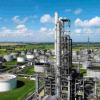Dear Experts
Assume a shell&tube exchanger (steam heated).
Steam temperature is 160, maximum 190 and design 270 (Project Design Basis).
Process temperature is 60 C.
For steam side design temperature I have not any objection.
But for process side, I think 190 C is good option and not 60 plus some margin (e.g. 75 C).
I need some international code or practice that help me for this issue.
Ghasem
|
|
Design Temperature In Exchanger
Started by Ghasem.Bashiri, Jul 06 2011 07:57 AM
4 replies to this topic
Share this topic:
#1

Posted 06 July 2011 - 07:57 AM
#2

Posted 06 July 2011 - 08:43 AM
Suppose that steam is in tubes. Since steam contacts them, tube design temperature would be 270 oC, irrespectively of the fact that max fluid temperature outside of them is 60 oC.
We would also specify 270 oC as shell design temperature, to cover the case when process fluid is blocked in the exchanger and heated to maximum steam temperature. Shell design temperature of 190 oC would still be acceptable, though less conservative.
Suppose now that steam is in the shell. It contacts both shell and tubes, so design temperature of both should be specified as 270 oC.
Design temperature concerns piping or equipment rather than the fluid itself, most conservative case has to be adopted.
We apply above in work, though I do not know which standards or practices support it (Project, not Process, is officially responsible for design conditions here).
We would also specify 270 oC as shell design temperature, to cover the case when process fluid is blocked in the exchanger and heated to maximum steam temperature. Shell design temperature of 190 oC would still be acceptable, though less conservative.
Suppose now that steam is in the shell. It contacts both shell and tubes, so design temperature of both should be specified as 270 oC.
Design temperature concerns piping or equipment rather than the fluid itself, most conservative case has to be adopted.
We apply above in work, though I do not know which standards or practices support it (Project, not Process, is officially responsible for design conditions here).
Edited by kkala, 06 July 2011 - 08:47 AM.
#3

Posted 06 July 2011 - 09:33 AM
Hello,
For heat exchangers refer to TEMA section RCB-1.42. For the eighth edition it is on page 24. You will need to know the metal temperature. Also refer to ASME Boiler & Pressure Vessel Code VIII Division 1 in section UG-20.
Good Luck,
For heat exchangers refer to TEMA section RCB-1.42. For the eighth edition it is on page 24. You will need to know the metal temperature. Also refer to ASME Boiler & Pressure Vessel Code VIII Division 1 in section UG-20.
Good Luck,
#4

Posted 06 July 2011 - 02:42 PM
It would have been better if you had specified which side you have placed steam and which side a process fluid.
So far i have seen, design temperature of both the side fluid is considered as maximum anticipated process temp+ margin as per the contract document or practice in respective company (e.g. max. operating temp+30degC). However the stress calculation and thickness calc is always performed considering various case (startup, normal operation, shut down etc.).
keep in mind that tube will experience metal temperature on both the side, it will never experience shell fluid bulk temperature. So there is no point in considering shell side maximum temperature for tube design temp if shell side fluid is hotter than tube side fluid. if you have placed steam in tube side then it is very much understood that shell is never going to experience higher temp than shell side fluid max. temp. However tubesheet thickness calc is checked considering various cases.
In your case if steam is placed in shell side then its not necessary to take steam max. temp 190degC in your case as tube design temp because tube is not going to experience 190degC but it will be lesser than this that is outside tube metal temperature. refer HTRI thermal design output for metal temp on both side.
While giving design condition on tube side or say process side in your case you can go ahead with your contract requirement condition. Mechanical design people will take care mechanical design calculation considering metal temp. and other cases.
also consult your static equipment people for better clarity in subject matter.
Lets see what others' have to say
So far i have seen, design temperature of both the side fluid is considered as maximum anticipated process temp+ margin as per the contract document or practice in respective company (e.g. max. operating temp+30degC). However the stress calculation and thickness calc is always performed considering various case (startup, normal operation, shut down etc.).
keep in mind that tube will experience metal temperature on both the side, it will never experience shell fluid bulk temperature. So there is no point in considering shell side maximum temperature for tube design temp if shell side fluid is hotter than tube side fluid. if you have placed steam in tube side then it is very much understood that shell is never going to experience higher temp than shell side fluid max. temp. However tubesheet thickness calc is checked considering various cases.
In your case if steam is placed in shell side then its not necessary to take steam max. temp 190degC in your case as tube design temp because tube is not going to experience 190degC but it will be lesser than this that is outside tube metal temperature. refer HTRI thermal design output for metal temp on both side.
While giving design condition on tube side or say process side in your case you can go ahead with your contract requirement condition. Mechanical design people will take care mechanical design calculation considering metal temp. and other cases.
also consult your static equipment people for better clarity in subject matter.
Lets see what others' have to say
#5

Posted 15 September 2011 - 05:01 PM
Ghasem,
You have failed to clearly state your parameters. I will assume that 60C is the outlet temperature of your process fluid and not the inlet (cold) temperature. So you are happy with a maximum steam temperature of 190C and a steam side design temperature of 270C. You do appreciate that the 270C temperature is arrived at by starting with the maximum expected temperature and adding "some margin" as you so inelegantly have put it? So what do you have against using the same approach on the process side? With no additional information, I would set the process side design temperature at 140C. I arrive at this by noting that you have used a (I'll call it) safety margin of 80C on the steam side, so I'd be inclined to use the same margin on the process side. 60 + 80 = 140C, my selected design temperature. (By the way, I feel an 80C margin is way too much; normally say 30C would be sufficient.)
You have failed to clearly state your parameters. I will assume that 60C is the outlet temperature of your process fluid and not the inlet (cold) temperature. So you are happy with a maximum steam temperature of 190C and a steam side design temperature of 270C. You do appreciate that the 270C temperature is arrived at by starting with the maximum expected temperature and adding "some margin" as you so inelegantly have put it? So what do you have against using the same approach on the process side? With no additional information, I would set the process side design temperature at 140C. I arrive at this by noting that you have used a (I'll call it) safety margin of 80C on the steam side, so I'd be inclined to use the same margin on the process side. 60 + 80 = 140C, my selected design temperature. (By the way, I feel an 80C margin is way too much; normally say 30C would be sufficient.)
Similar Topics
Pipe Fluid Temperature Increase Due To Solar LoadingStarted by Guest_HeemeshJ126_* , 06 Apr 2016 |
|
|
||
Design Capacity Of Hydrogen Pullet During Hydroprocessing Units UpsetStarted by Guest_Divid Kelin_* , 18 Jun 2025 |
|

|
||
Hot Oil Loop / Heating Medium DesignStarted by Guest_Lyne_* , 30 Mar 2024 |
|

|
||
Hello, Design Of Natural Gas Liquefaction Processes.Started by Guest_guoyinyanliner_* , 18 Jun 2025 |
|

|
||
Distillation Tower Top And Bottom Temperature And PressureStarted by Guest_student55_* , 27 Mar 2016 |
|
|

 FB
FB










